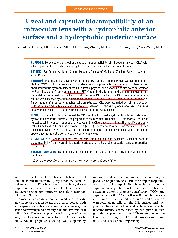摘要
PURPOSE: To evaluate the uveal and capsular biocompatibility of intraocular lenses (IOLs) with a hydrophilic anterior surface and a hydrophobic posterior surface in a rabbit model. @@@ SETTING: Eye Center, Affiliated Second Hospital, College of Medicine, Zhejiang University, Hangzhou, China. @@@ METHODS: Modified silicone IOLs were produced by grafting 2-methacryloyloxyethyl phosphorylcholine (MPC) onto the anterior IOL surface using a plasma technique. A contact-angle test characterized the hydrophilicity of the IOL surface; physical and optical properties were determined by State Food and Drug Administration (SFDA) standards. Rabbits had phacomulsification and implantation a modified silicone IOL, a control silicone IOL, or a hydrogel IOL. Postoperative inflammation was assessed by aqueous flare measurement, and PCO was evaluated by software analysis. Three months after surgery, attached cells on extracted IOLs were evaluated by light microscopy; PCO was evaluated by Miyake-Apple technique. Histologic sections of globes were used to assess lens epithelial cells (LECs) and extracellular matrix in the capsular bag. @@@ RESULTS: Contact angle data showed the MPC-modified IOL had a hydrophilic anterior surface and hydrophobic posterior surface. The properties of the modified IOLs met SFDA standards. There was no statistical difference in aqueous flare between the IOL groups at any time. The modified and control IOLs had less PCO than the hydrogel IOLs (P<.05). There were fewer cells on modified IOLs than on silicone IOLs (P<.05). The LECs and cortical remnants on modified IOLs had a rapid, fibroblastic appearance at the optic periphery; the center was clear. @@@ CONCLUSIONS: Results suggest that the MPC-modified IOL has excellent uveal and capsule biocompatibility from hydrophilic anterior surface and hydrophobic posterior surface properties, respectively.
- 出版日期2010-2
- 单位浙江大学
